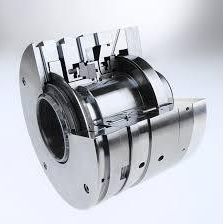Flow vs pressure control in dry gas seals

The term “flow control” refers to the philosophy behind the control scheme. It is independent of the variables being manipulated. When a flow control system is described, it means that the system is designed to ensure a proper gas velocity by controlling the flowrate across the process labyrinth.
Flow control systems are based on the following principle: A pressure differential across the orifice in the flowmeter is set to satisfy flow velocity requirement across the process labyrinth at a particular compressor operating point. The set point entered as a control parameter corresponds to the flowrate that provides the required velocity across the process labyrinth. Usually it corresponds to the flowrate that yields a velocity of 5m/s (~15 ft/s) at a double radial clearance of the labyrinth at normal operating conditions.
This article contains excerpts from the paper, “Examination of Methods of Dry Gas Seal Supply, Regulation, and Monitoring” by Vladimir Bakalchuk and Sreenivasulu Chinnaswamy of Flowserve, Kevin Dwyer and Rich Hosanna of John Crane, Robert C. Eisenmann Jr. of BP and Jim McCraw of VAM Consulting at the 2018 Asia Turbomachinery Symposium.
Change in the sealing pressure propagates a pressure wave with the speed of sound towards the flow transmitter. This wave changes the pressure differential detected by the differential pressure transmitter indicating a change in the flowrate. Change of the pressure differential across the orifice from the preset value signals the flow control valve to open or close adjusting the flowrate until the differential pressure across the orifice returns to the preset value.
In the case where a single control valve is controlling the flow to two seals, a low select is employed. The low select ensures that the flow to each seal will be greater than or equal to the predefined requirement. The flow control system works by having the control valve act as the greatest restriction, choking and fully determining the flowrate.
Flow control systems greatly simplify the calculations required in designing systems. As such there is less uncertainty introduced by engineering calculations, and a more accurate flowrate can be supplied to maintain the minimum velocities. The major issue in flow control systems is the accuracy of the flow measurement for the transmitters. Every flow transmitter should be calibrated for a specific set of operating conditions. The density of the gas is used when determining the flow, and as such any change in the density of the seal gas will affect the reading of the transmitter. Users should be aware of the inaccuracies of the transmitter readings when setting and responding to the alarm conditions in the compressor, especially during startup and shutdown conditions. At these conditions the pressure or gas composition are often different from normal operating pressure, which affects gas density and consequently the instruments won’t be able to read accurately.
As with flow control, pressure control doesn’t necessarily mean that pressure is the variable being measured and controlled. The phrase “pressure control” refers to the philosophy employed. In this case a differential pressure is maintained across the process labyrinth between a reference (balance piston cavity) and the pressure downstream of the control valve. This differential pressure should ensure that the minimum velocity is maintained across the process seal. In order to ensure the proper pressure differential is maintained, it’s important to account for pressure losses throughout the system in the preset differential pressure. There are pressure losses due to the following factors: Gas friction (proportional to the pipe length and the square of the gas velocity), pressure loss in pipe bends (proportional to pipe length and square of gas velocity), pressure loss/drop in compressor porting (cross-drilling of a diameter smaller than pipe cross-section), gas expansion in the primary seal supply cavity (port annulus area is smaller than the cavity cross section), and pressure drop across the process seal.
The differential pressure transmitter records the pressure differential between the seal gas supply pressure and the sealing pressure (the pressure directly downstream of the process labyrinth). The control valve then acts to maintain a specified differential pressure between these two points. By maintaining this differential pressure, the system is designed to maintain the minimum velocity across the labyrinth. The sealing pressure reference has historically been taken from the balance piston cavity. It is important that the tap for the sealing pressure reference line is located at the top of the cavity. This prevents possibility of liquids entering the sensing line.
The tap referencing the seal gas pressure should be placed as far downstream from the control valve in the line as possible, and ideally, immediately upstream of the compressor casing. Additionally, the tap should be as physically close to the compressor casing as possible. The recommended system shows this configuration, whereas figure 4 shows a more common configuration frequently found in the field. Placing the seal gas pressure reference tap as far downstream as possible helps to maintain an accurate measurement by minimizing the effects of any pressure losses caused by piping losses, gas expansion in the compressor annulus, or any other sources of pressure loss.
As mentioned above, when sizing pipework and the control valve for a pressure control system, piping losses should be factored into any calculations, particularly when determining the set points of the control valve. In addition to the differential pressure transmitter, a flow transmitter is included to aid in seal monitoring and failure analysis. Pressure control systems suffer from a few drawbacks. Mainly the differential pressure required to maintain the minimum velocity across the labyrinth is generally incredibly small. So small as to be difficult to both measure and control with typical equipment. To compensate for this, additional differential pressure has to be provided in order to yield sufficient operating margin, and cover the design assumptions.